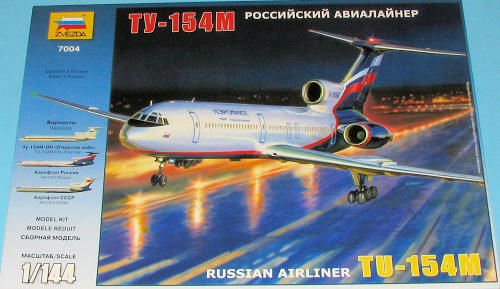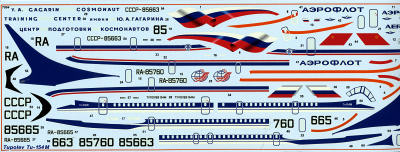
Zvezda 1/144 Tu-154M
| KIT #: | 7004 |
| PRICE: | $21.90 MSRP |
| DECALS: | Three options |
| REVIEWER: | Scott Van Aken |
| NOTES: | New mold kit |

| HISTORY |
The Tupolev Tu-154 (Russian: Туполев Ту-154) is a Soviet medium-range trijet airliner similar to the Boeing 727. The mainstay of Russian airlines for several decades, the Tu-154 has carried about half of all passengers flown by Aeroflot and its subsidiaries, or approximately 137 million passengers per year, and has been exported and operated by at least 17 foreign airlines. It remains the standard airliner for domestic routes in Russia and other states of the former Soviet Union, and to a lesser extent in eastern Europe. Designed to cope with unpaved and gravel airfields, the plane often operates in extreme Arctic conditions.
The Tu-154 first flew on October 4, 1968. Commercial service began in February 1972, and production ended in 2006. About 900 Tu-154s have been built, 500 of which are still in service.
In 1988 a modified Tu-154 (dubbed Tu-155 and Tu-156) successfully flew on liquid hydrogen and in 1989 on liquefied natural gas used as a fuel in its engines.
The Tu-154M, and the subject of this kit, is the deeply upgraded version, which first flew in 1982 and entered mass production in 1984. It uses more fuel-efficient Soloviev D-30KU-154 turbofans. Together with significant aerodynamic refinement, this led to much lower fuel consumption and therefore longer range, as well as lower operating costs. The aircraft has new double-slotted (instead of triple-slotted) flaps, with an extra 36-degree position (in addition to existing 15, 28 and 45-degree positions on older versions), which allows reduction of noise on approach. It also has a relocated auxiliary power unit and numerous other improvements. Manufacture continued through 2006. Max. take-off weight increased first to 100,000 kg, then to 102,000 kg. Some aircraft are certified to 104,000 kg. Tail numbers are 85616 (prototype), production aircraft from 85606 and on (except 85804, which is re-imported Tu-154B-2). About 320 were manufactured. Production ended in 2006. No new airframes have been built since the early 1990s, and production since then has involved assembling airplanes from components on hand. This is the most widely used version in the former Soviet states.
| THE KIT |
The only other injected plastic kit of this kit is the rather difficult to find VEB 1/100 kit, which is a great deal cruder than this one and is best left to collectors so it is nice to see a new mold one in one of the standard airliner scales.
I know that I've mentioned in the past how many overlook Zvezda when it comes to choosing kits and it is a shame as they make a number of interesting types. Not only that, but more recent ones are, like this kit, superbly molded, with exterior detailing as good as the best in the industry. This kit is free of flash, depressed areas and has none of the nasty ejector pin marks on wheels, gear doors and landing gear that one finds with some other kits. The fuselage has all the windows open with clear inserts. This is something that many airliner modelers prefer, though there are others that would rather have a smooth fuselage with decals for cabin and cockpit windows. The clear parts are well done and the cockpit transparencies are part of an upper, forward fuselage section. There is no cockpit so that and the interior should probably be painted a dark color. 20 grams is needed for nose weight with plenty of space to install it.
The upper wings are molded with the trailing edge of the underside as part of the piece. Makes for nice, sharp edges. The intake and exhaust fans do a look a bit simplified for my tastes, but are still nicely done. The kit has an excellent set of landing gear and wheels which are nicely detailed. One can build this one wheels up as Zvezda has provided a display stand, something I feel should be part of every airliner kit.
 As
it is a pretty simple kit (most airliner kits are not fiddly), instructions do
not take up a lot of space. Color information is provided with Model Master
references and there are three painting and markings options. First is an
Aeroflot version in white over light grey as flown before the dissolution of the
Soviet Union. Second is a later variant with an aluminum fuselage and big, flag
on the fin as shown on the box art. The third version is from the Y.A.Gagarin
Cosmonaut Training Center in overall white. This one also has windows on the
belly of the plane that will need to be added during construction (the
instructions show how to do this). Decals are very nicely printed and quite
colorful. I've not had the best of luck with Zvezda markings, but it has been
several years since I built one of their kits and these do look different.
Still, best to check with a marking you won't be using to see how they will
respond to setting solutions as most of the schemes will need it.
As
it is a pretty simple kit (most airliner kits are not fiddly), instructions do
not take up a lot of space. Color information is provided with Model Master
references and there are three painting and markings options. First is an
Aeroflot version in white over light grey as flown before the dissolution of the
Soviet Union. Second is a later variant with an aluminum fuselage and big, flag
on the fin as shown on the box art. The third version is from the Y.A.Gagarin
Cosmonaut Training Center in overall white. This one also has windows on the
belly of the plane that will need to be added during construction (the
instructions show how to do this). Decals are very nicely printed and quite
colorful. I've not had the best of luck with Zvezda markings, but it has been
several years since I built one of their kits and these do look different.
Still, best to check with a marking you won't be using to see how they will
respond to setting solutions as most of the schemes will need it.
| CONCLUSIONS |
I dare say that this is one of the few modern Russian airliner kits around. It is one that is most welcome and I can only hope that Zvezda decides to do more.
| REFERENCES |
http://en.wikipedia.org
October 2008
Thanks to
www.dragonmodelsusa.com for the preview kit. Get yours
today from your local shop or on-line. If you would like your product reviewed fairly and quickly, please
contact
me or see other details in the
Note to
Contributors.